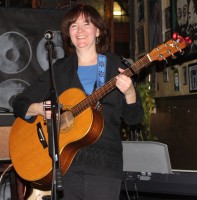Paul Tarvydas, TSA member, is currently participating in Pat Pattison’s online songwriting course. Paul recently published this fascinating account of a previous Pat Pattison experience on his own blog, https://guitarvydas.wordpress.com/
____________________________________________________________________________
There was a question about “perspective”. I have direct experience with this subject — I presented one of my songs in a Pattison seminar and it sent him off on long lecture about perspective (he left me on stage during the lecture and kept gesturing at me).
I’ve included the before-and-after lyric, below. Pat only saw the “before”.
From the perspective of perspective, one can see that the old lyric wanders all over the place. Verse one is framed as “we / us / ours”. The singer and everyone listening is included.
The chorus is framed as “you”. The singer has switched perspective and is pointing fingers at the listeners.
Verse three is framed in the “I” perspective – the singer is talking about himself.
Verse four goes back to the “us” perspective.
That was what Pattison refers to as Swampy — the creature who emerges from the lagoon and throws up a bunch of disconnected ideas onto the beach. It looks like the Professor didn’t show up that day…
Haunt You in the Night (old)
There was this girl in Viet Nam
We snapped her picture as she ran
She was running from her home
It was burning with napalm
She told us that this war
Was ours to lose
chorus:
How do you sleep
Knowing that it’s real?
Close both your eyes
Keep watching all those lies
Don’t you think that
They’ll come back and
Haunt you in the the night?
Don’t you think that
They’ll haunt you in the night?
I listen daily to the news
I know they want to change my views.
I see heartache and pain —
They tell me “it’s OK”
But something in me tells me
That we’re damned
[chorus]
bridge:
Go back to sleep, and dream
Go back to sleep, don’t hear the screams
There was this guy in Abu Ghraib
Hooded, wired, ready for his grave
He stood up on a box
He told us that we’d lost
He told us that our morals
Have gone astray
Amazingly, I left the lecture and didn’t throw the song out.
I sat down and tried to adopt a single perspective throughout the whole song. It was incredibly difficulty! Try it — see if you can rewrite the above lines to all have a “you” perspective…
I finally stumbled onto something that snapped the intent of the song into focus — the “I” perspective (the “royal I”?). I rewrote the lyric as if I was the main participant and I’m describing what I lived through to the listener. In reality, listeners don’t care about me (the songwriter / singer) — they only care about themselves and how they feel. Which makes the “I” perspective even more powerful here — the listener pins all of this on him/herself. There’s a sense of immediacy.
Haunt Me in the Night
There was this girl in Viet Nam
I snapped her picture as she ran
She was running from her home
It was burning with napalm
She told me
This war was mine to lose
I listen daily to the news
I know they want to shape my views
I see heartache and pain
They tell me it’s OK
Now I know
That peace is war these days
chorus:
How can I sleep
Knowing this is real?
Close both my eyes
I keep seeing through the lies
And I know those dreams
They’ll haunt me
In the night
I know those dreams
They’ll haunt me
In the night
bridge:
I go back to sleep and I dream
I go back to sleep so I won’t hear them scream
There was this guy in Abu Ghraib
He was hooded, he was wired, he was ready for his grave
He stood up on a box
He told me that I’d lost
He’s coming back to be my ghost some day
It’s an interesting illustration of how revisiting and changing the perspective of a song can raise it to a different level. I’m going to use this technique again.
https://soundcloud.com/guitarvydas-1/haunt-me-in-the-night




